Master the art of effective profile page UI design in this guide, complete with practical tips, examples, and upcoming trends.
Many websites, apps, and digital products require a user profile page or screen. This dedicated space hosts the user’s personal information and gives them quick access to key features and functions.
User profile pages form an essential part of the overall user experience—and they present a great opportunity to delight and engage your users.
But what does effective profile page UI design look like in action? What elements should your profile page include, and what best practices should you adhere to?
We’ll cover everything you need to know in this guide—with real-world examples to inspire you.
Contents:
- What is a profile page in UI design?
- How to create a user profile page or screen: key elements to include
- Tips and best practices for effective profile page UI design (with examples)
- Profile page UI design trends to watch out for in 2025
- Key takeaways
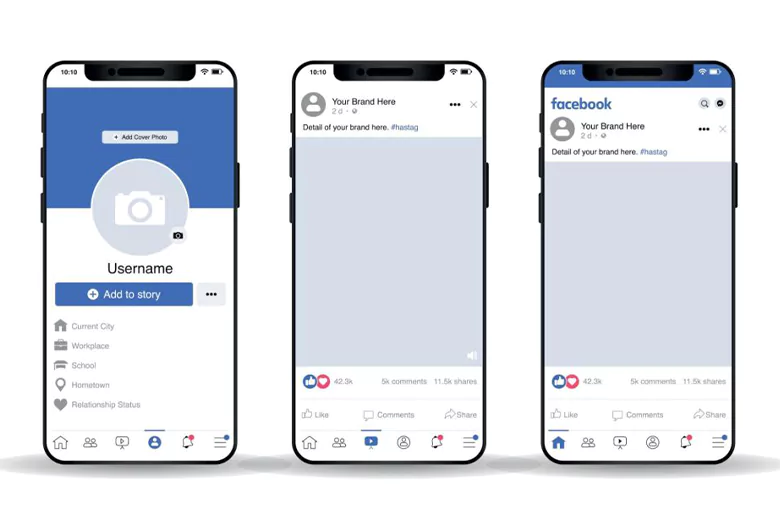
What is a profile page in UI design?
A profile page or profile screen is a dedicated space within an app, website, or digital platform that houses individual user profiles. It acts as a central hub where users can view and manage their personal details, and update their preferences.
Consider your favorite social media apps or your preferred movie streaming platform. When signing up for such services, you create a unique user profile featuring relevant details such as your name and profile picture. This is all accessible via your profile page.
Effective profile page UI design is a crucial part of the overall user experience. It should enable the user to accurately reflect their identity within the platform, and give them a sense of control over how they engage with the product.
How to create a user profile page or screen: key elements to include
A user profile page or screen should provide the user with a centralized, easily accessible space where they can manage their personal details, preferences, and activities.
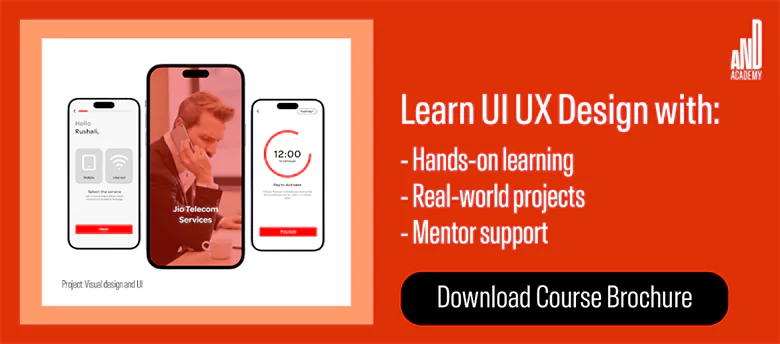
The exact elements required to create a user profile page depend on the context and what kind of functionality the profile page should offer.
Common building blocks for profile UI design include:
- A profile photo or avatar
- A username, display name, or handle
- A user bio or ‘about’ section
- Contact information with fields for the user’s email address, phone number, and relevant links (e.g. links to social media profiles or a personal website)
- An activity summary or relevant highlights (e.g. number of followers on social media or key stats for a fitness app)
- Editable settings and preferences
- Badges and achievements (in a language-learning app, for example)
- Shortcuts to key sections such as orders, activity history, or playlists.
Deciding which elements to include in your profile page UI design
A good profile page UI design should focus on clarity and usability, so it’s important to prioritize only the most essential elements.
So how do you decide which elements to include in your profile page UI design? Consider the following factors:
Your end users’ needs
As with all design decisions, think about who you’re designing for and what they need most from their profile page or screen.
How are they likely to interact with the profile page section? What fields and functionality will they need for an engaging, user-friendly experience with the product in question?
If you’re designing the profile page UI for a fitness app, for example, your users will want access to their workout history, progress tracking, personalized goals, and achievements.
The overall goals of the product
In addition to prioritizing user needs, your profile page UI design should also align with the broader goals of the product.
If you’re designing an e-commerce website, you’d want to make it as easy as possible for users to manage their orders and complete purchases. As such, your profile page UI might prioritize content such as order history, wishlists, and the user’s shipping details.
This ensures that your profile page UI design supports and enhances the product’s core purpose.
Customization and user control
Your users should feel a sense of ownership over their profile page, so it’s important to allow for a certain degree of customization.
When determining the key elements of your profile page UI design, aim to strike a balance between those that can be edited or customized—such as profile picture, name, and bio—and those that remain somewhat fixed.
Privacy and security
Consider where privacy and security fit into your profile page UI design. Where relevant, include features that enable users to update their privacy settings, manage their personal data, and go through additional security measures (such as account verification).
This gives your users a sense of control over their data, helping to build trust and ensure compliance with privacy regulations.
Ultimately, when determining what to include in your profile page UI design, you want to strike a good balance between functionality, simplicity, and user control. Prioritize elements that optimize for usability and customization without overwhelming users or cluttering the page.
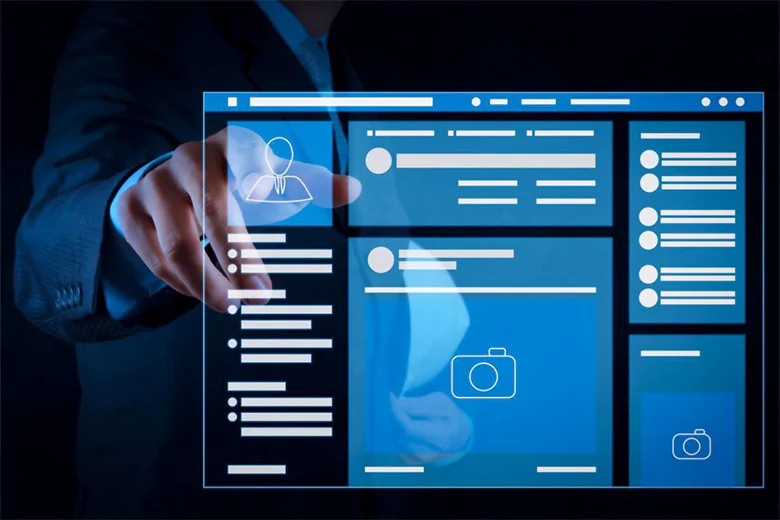
Tips and best practices for effective profile page UI design (with examples)
Once you’ve chosen the core elements and features for your profile page UI design, you’ve got the fundamental building blocks in place. Next, follow these actionable tips and best practices for effective profile page UI design.
1. Establish a clear visual hierarchy
Visual hierarchy is one of the fundamental UI design principles, and it plays a critical role in profile page UI design. A well-structured profile page ensures that users can quickly identify, and interact with, the most important elements—creating an intuitive user experience.
Position profile page elements in order of priority, with more important elements placed prominently at the top of the screen. At the same time, use size, contrast, and spacing to create a natural flow that guides the user’s attention.
In a fitness app, for example, you’d place the user’s name and profile picture at the top, followed by their current progress (e.g. daily step count or workout streak for the week). You’d then place secondary information such as achievement badges and workout history lower down on the page.
Profile screen UI design example from the Nike Training mobile app
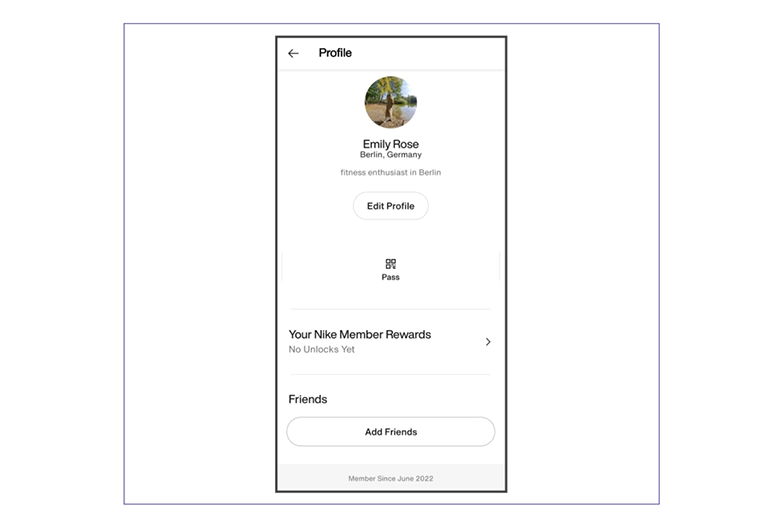
This profile screen from the Nike Training app follows a clear, straightforward visual hierarchy. The user’s photo, name, location, and bio take center stage, with a large, easily accessible button enabling the user to edit their profile.
The user can quickly find the most important elements at the top of the screen, followed by secondary features (Member Rewards and Friends) lower down.
2. Opt for a predictable, consistent layout
Don’t try to reinvent the wheel with your profile page UI design. Users should feel comfortable and confident navigating their profile page, and a consistent and predictable layout helps to achieve this.
Stick with familiar design patterns that tap into your users’ mental models—that is, their expectations and preconceptions regarding how the page should look and behave.
Conduct competitor research to establish common design patterns and layouts that your target audience is already familiar with, then use these to inform your own profile page UI design.
If you’re designing a music streaming app, for example, and notice that most competitor apps follow certain conventions in their profile page UI design, you’ll want to adopt these in your designs, too.
Many industry-standard UI design software and tools like Figma, Sketch, and Adobe XD offer customizable templates and ready-made layouts for profile page UI design. These are a great place to start when creating familiar and consistent profile screens.
3. Optimize for mobile
When designing user profile pages, consider how they’ll appear across different devices. Be sure to optimize your profile page UI design for smaller screens, ensuring all elements are easy to tap, read, and navigate on mobile.
You might use a collapsible menu for account settings, for example, leaving more space to display high-priority content and features on mobile. Likewise, the mobile version of your profile page UI design might include larger buttons for editing the profile or logging out to enhance usability on smaller screens.
Profile UI design example from Airbnb
Check out these two profile page UI designs from Airbnb. The first is optimized for larger screens, while the second offers a much more streamlined version for mobile.
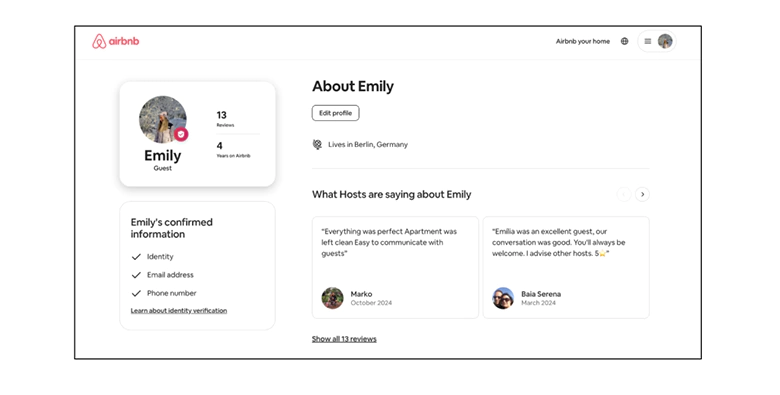
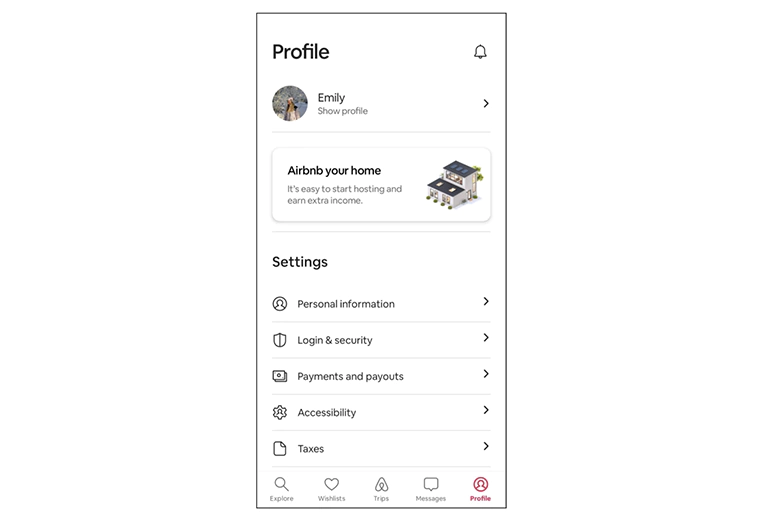
For more tips on how to optimize for mobile, check out our complete guide to mobile app UI design.
4. Provide contextual guidance
You want to make your profile page UI design as intuitive and user-friendly as possible, and that may require providing additional guidance for the user.
Where necessary, consider including tooltips, inline instructions, or small icons with explanations to clarify specific features or fields. This helps users understand the purpose of each element, facilitating their interaction with the page.
Consider the process of uploading your resume to your profile page in a job search platform. Next to the upload button, you might see a tooltip that explains the preferred file formats and how your resume will be used. That’s a great example of contextual guidance in profile page UI design.
Profile UI design example from Indeed
This profile page example from the popular job site Indeed shows how contextual guidance can support the user as they navigate their profile screen. Many functions and features on the page are accompanied by a short line of explanatory text, providing clarity for the user and explaining how each element can be used.
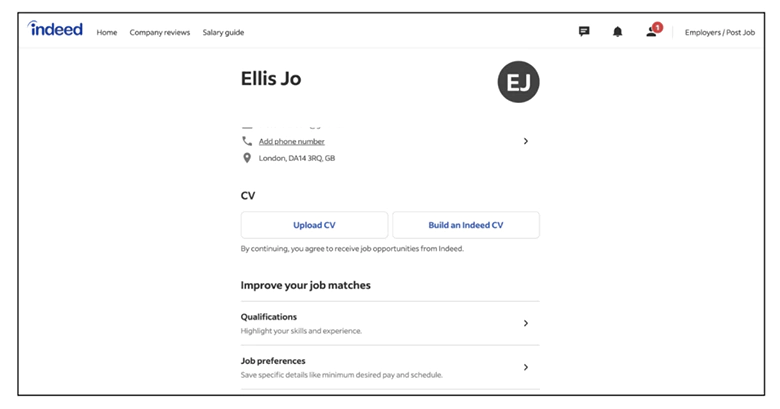
5. Foster user engagement
Your profile page UI design offers a great opportunity to engage users and add some fun to the user experience (where appropriate). Depending on the context, consider incorporating interactive features and personalized content.
If you’re designing the profile page for a language-learning app, think about how your profile page UI design can motivate the user and keep them on track for their goals. You might feature progress bars, badges, and motivational messages within the profile screen.
These small touches will help keep the user engaged, create an experience that feels unique and personal, and encourage them to interact with their profile page more often.
Profile page UI design trends to watch out for in 2025
Want to get ahead of the latest trends in profile page UI design? Here’s what we’re anticipating in 2025 and beyond.
Personalization
With advancements in data analytics, machine learning, and AI, personalization is set to be a major trend in profile page UI design.
It’s never been easier to collect data about user behaviors and preferences and to use that data to create highly personalized designs and experiences. In the context of profile page UI design, this means customizing the layout, content, and features based on individual user needs and interests.
By leveraging data such as past actions, search history, and demographic information, you can present users with relevant recommendations, content, and personalized calls to action that keep them engaged and improve overall satisfaction.
This makes the profile page feel more personal and relevant to the user, creating an experience that’s tailored just for them.
Micro-interactions and animations
While functionality will always remain a top priority in profile page UI design, we’re seeing a shift away from static designs towards more dynamic and engaging profile screens.
Increasingly, micro-interactions and animations will be used to enhance usability and make profile pages more enjoyable to use. For example, you can use subtle animations to provide visual feedback when the user updates their profile information or settings.
Brands like LinkedIn and Instagram are already leveraging this trend in profile page UI design, and we expect many more to follow suit.
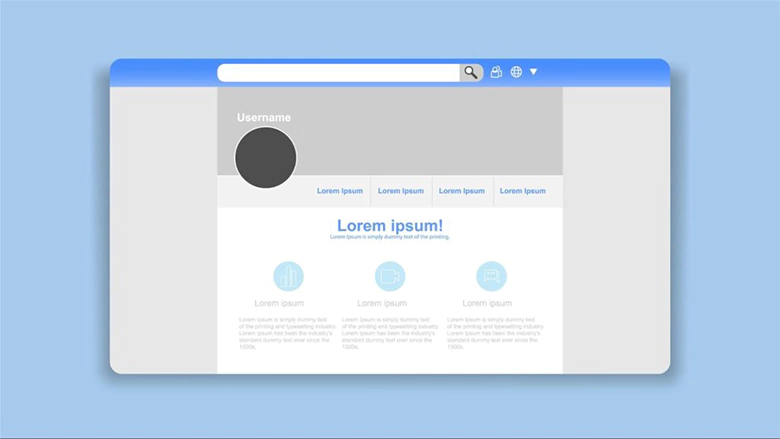
Social integration and community
Another significant trend in profile page UI design is the integration of social and community features. Many profile page designs now incorporate social elements such as the ability to follow others, share content, join groups, and comment on other people’s activities.
This helps to foster a sense of community and engagement, making the profile page feel more like a social hub than simply a static dashboard.
Designers will increasingly leverage this trend to delight and engage users and set their products apart from competitors.
Together, these trends are driving a shift towards more engaging, dynamic, and personalized profile page UI design—enhancing the overall user experience and enabling brands to foster deeper connections with their users.
Key takeaways
Creating user-friendly, accessible, and engaging profile pages is an important part of the UI design process.
By following fundamental design principles such as visual hierarchy, spacing, and consistency, you can create profile pages and screens that are easy to navigate and contribute to a positive user experience overall.
With the tips, examples, and best practices we’ve shared in our guide, you’ll be mastering the art of effective profile page UI design in no time. For further design guides, check out the following:
- Login Page UI Design: Tips, Best Practices, Examples, and Trends to Watch out for in 2025
- Your Ultimate Guide To Form UI Design (With Examples)
- What Is a User Persona and How Do You Create One?
Learn the end-to-end UI design process with AND Academy
If you’re looking for more formal UI design training, consider studying UI design with AND Academy. Through interactive, expert-led sessions and practical projects, you’ll learn the UI design process from end to end—and build out a professional UI UX design portfolio as you go. You can check out this project by Shantanu Pathak to understand how AND’s comprehensive modules impact our learners’ work!
Next Steps
In case you think you need further assistance, here are some of our resources you can consider:
- Watch this session by Shiva Viswanathan, Design Head of Ogilvy Pennywise, and Naman Singh, Product Experience Designer at RED.
- Talk to a course advisor to discuss how you can transform your career with one of our courses.
- Pursue our UI UX Design courses - all courses are taught through live, interactive classes by industry experts, and some even offer a Job Guarantee.
- Take advantage of our scholarship and funding options to overcome any financial hurdle on the path of your career transformation.
Note: All information and/or data from external sources is believed to be accurate as of the date of publication.










